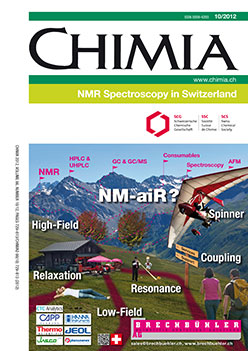Combination of Homonuclear Decoupling and Spectral Aliasing to Increase the Resolution in the 1H Dimension of 2D NMR Experiments
DOI:
https://doi.org/10.2533/chimia.2012.764Keywords:
Androst-4-ene-3, 17-dione, Broadband homonuclear decoupling (bbhd), Fast methods, High-resolution nmr, Spectral aliasingAbstract
Broadband homonuclear decoupling (BBHD) in the indirect 1H dimension of 2D experiments can be obtained using a modified Zangger and Sterk combination of a selective pulse with a pulsed-field gradient. The coupling structure of signals is reduced to a singlet along the F1 dimension at the cost of a sensitivity loss. With the classical sampling in F1, the full resolving power of BBHD-experiments requires very long acquisition times. Spectral aliasing can reduce the number of time increments accessing the top resolution of homodecoupled spectra of small molecules by two orders of magnitude. The TOCSY spectra of androst-4-ene-3,17-dione are shown as an example.Downloads
Published
2012-10-31
Issue
Section
Scientific Articles
License
Copyright (c) 2012 Swiss Chemical Society

This work is licensed under a Creative Commons Attribution-NonCommercial 4.0 International License.
How to Cite
[1]
Chimia 2012, 66, 764, DOI: 10.2533/chimia.2012.764.







